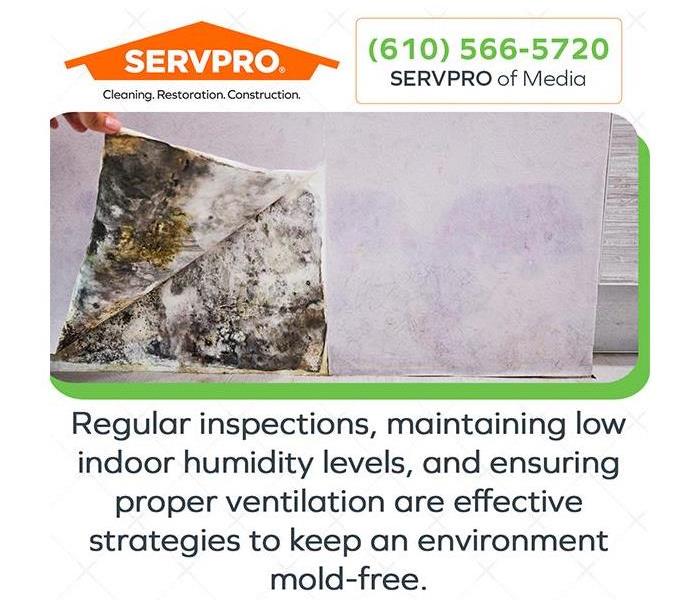Recent Posts
Rapid Water Damage Restoration in Springfield, PA: How SERVPRO of Media and Central Delaware County Responded to an Emergency
7/23/2024 (Permalink)
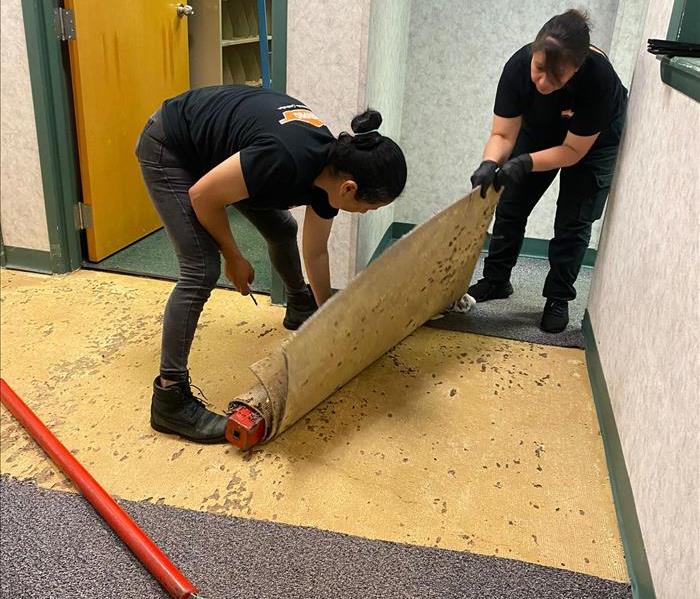 A local storm flooded this office building. Our team acted quickly to restore this local business.
A local storm flooded this office building. Our team acted quickly to restore this local business.
Quick Response to a Local Emergency
On a rainy Tuesday morning, SERVPRO® of Media and Central Delaware County received an urgent call from a local business owner in Springfield, PA. A significant water leak had caused extensive flooding throughout their office building. Understanding the urgency, our team quickly mobilized and arrived at the scene within an hour, ready to tackle the challenge head-on.
Thorough Assessment and Action Plan
Upon arrival, our highly trained technicians conducted a thorough assessment of the situation. We discovered that a burst pipe had caused severe water damage to multiple floors. After discussing the findings with the business owner, we devised a comprehensive action plan to address the damage and restore the property as quickly as possible.
Advanced Equipment and Expertise at Work
Using state-of-the-art equipment, including powerful water extractors and industrial-grade dehumidifiers, our team began the water removal process immediately. Our water damage restoration experts meticulously dried and dehumidified the affected areas to prevent further damage and potential mold growth.
Keeping the Customer Informed
Throughout the restoration process, we maintained open lines of communication with the business owner. We provided regular updates on our progress and addressed any concerns promptly. Our commitment to transparency and customer satisfaction was evident in every step taken.
The SERVPRO Difference
Within a few days, SERVPRO of Media and Central Delaware County restored the office building to its pre-damage condition. The business owner was amazed at the efficiency and professionalism of our team, stating, “SERVPRO made it like it never even happened.”
This recent project exemplifies our dedication to providing our community with top-notch water damage restoration services. We are proud to serve Media, Springfield, Wallingford, and the surrounding areas and will continue to be there for our neighbors whenever disaster strikes.
Learn More About Our Services
For more information about our water damage restoration, fire damage restoration, and other services, visit our website. If you ever need emergency restoration services, don’t hesitate to contact SERVPRO of Media and Central Delaware County. We are Here to Help® 24/7.
Unveiling the hidden dangers of mold infestation
5/21/2024 (Permalink)
Mold infestation can pose significant risks to property integrity. Excess moisture is the primary catalyst for mold growth, creating an ideal environment for mold spores to thrive. This can occur due to roof leaks, faulty windows or pipes, flooding, or high humidity levels.
Our company is committed to ensuring that our customers understand the risks and causes of mold infestation. By providing comprehensive information on these topics, we aim to empower homeowners to take proactive measures to prevent mold growth and protect their properties.
Through informative and accessible content, we strive to establish our company as a trusted resource for mold remediation services. By addressing the concerns and questions of our audience, we can build credibility and trust, ultimately driving organic traffic to our website and generating leads for our business.
Causes of mold growth in homes
Understanding the underlying causes of mold growth in homes is essential for effective mold prevention and mold remediation strategies. Identifying these causes allows homeowners to take proactive measures to mitigate moisture issues and create a healthier indoor environment.
Sources of moisture conducive to mold growth
Mold requires moisture to thrive, making any source of water leakage or accumulation a potential catalyst for mold growth. Common sources of moisture conducive to mold growth include leaking pipes, roof leaks, condensation buildup, and flooding. Additionally, high humidity levels, inadequate ventilation, and dampness in basements or crawl spaces can create ideal conditions for mold to flourish.
Common indoor environments where mold thrives
Mold can thrive in indoor environments with elevated moisture levels and is conducive to growth. Areas such as bathrooms, kitchens, basements, and attics are particularly susceptible to mold infestation due to their frequent exposure to moisture. Additionally, areas with poor ventilation or inadequate airflow, such as closets and wall cavities, may harbor mold growth. Understanding these common environments can help homeowners effectively target their prevention and remediation efforts.
Key steps for mold remediation and removal
Mold remediation and removal are crucial for restoring indoor air quality and preventing further damage to homes and buildings. Effective remediation involves key steps to identify, contain, and eliminate mold growth while addressing the underlying moisture issues. Here are the essential steps for mold remediation and removal:
Assessment and inspection
The first step in mold remediation is to assess and inspect the affected areas thoroughly. This involves identifying the extent of mold growth, determining the underlying cause of moisture, and assessing any structural damage. Professional inspectors may use specialized equipment such as moisture meters and thermal imaging cameras to pinpoint areas of concern accurately.
Containment
Once the extent of mold growth has been determined, it's essential to contain the affected areas to prevent the spread of mold spores to uncontaminated areas. This typically involves sealing the contaminated area with plastic sheeting and using negative air pressure to direct airflow outside the building. Containment measures help minimize cross-contamination and protect occupants and workers during remediation.
Mold removal
The next step is the physical removal of mold from contaminated surfaces. Depending on the extent of the infestation and the type of materials affected, mold removal methods may vary. Non-porous surfaces can usually be cleaned and disinfected with commercial mold remediation products or a bleach solution. However, porous materials such as drywall, carpeting, and insulation may need to be removed and replaced to eliminate mold growth effectively.
Drying and dehumidification
After mold removal, the affected areas must be thoroughly dried to prevent moisture buildup and inhibit future mold growth. Industrial-grade air movers and dehumidifiers often accelerate drying and restore normal humidity levels. Proper drying is crucial for preventing mold recurrence and ensuring the long-term success of remediation efforts.
Cleaning and disinfection
Once the affected areas have been dried, they should be cleaned and disinfected to remove residual mold spores and prevent regrowth. Surfaces can be scrubbed with a detergent solution or antimicrobial cleaner to remove mold stains and surface contaminants. Following proper safety protocols and using personal protective equipment during cleaning is essential to minimize exposure to mold and cleaning agents.
Prevention strategies
Finally, implementing preventive measures is key to reducing the risk of future mold infestations. This may include repairing leaks, improving ventilation, and addressing any underlying moisture issues. Regular inspections and maintenance can help identify potential mold growth early and prevent significant damage to homes and buildings.
Homeowners and property managers can effectively address mold infestations and create a healthier indoor environment for occupants by following these key mold remediation and removal steps. For large or severe mold problems, professional assistance may be necessary to ensure thorough remediation and prevent recurrence.
Step 1: Inspection and assessment
Before proceeding with mold remediation and removal, conducting a thorough inspection and assessment of the affected areas is crucial. This initial step is essential for understanding the scope of the mold problem and developing an effective remediation plan. Here's what's involved in the inspection and assessment process:
Identifying areas of mold growth
The first task during the inspection is to identify all areas where mold is present. Mold can often be found in damp, dark, and poorly ventilated areas such as basements, bathrooms, attics, and crawl spaces. However, mold can also grow in less obvious places, such as behind walls, under flooring, and inside HVAC systems. Using specialized tools and equipment, inspectors carefully examine visible and hidden areas for signs of mold growth, including discoloration, musty odors, and moisture damage.
Assessing the extent of mold damage
Once areas of mold growth have been identified, the next step is to assess the extent of the damage. This involves determining how widespread the mold infestation is and evaluating the structural integrity of affected materials. Inspectors may use moisture meters, infrared cameras, and other diagnostic tools to measure moisture levels and identify areas of water intrusion. By understanding the full extent of the mold problem, remediation professionals can develop a comprehensive plan to address the issue effectively.
During the inspection and assessment, it's essential to document findings through photographs, written reports, and moisture readings. This documentation helps guide the remediation process and serves as a record of the conditions before and after remediation for insurance purposes and legal documentation.
By thoroughly inspecting and assessing the affected areas, remediation professionals can identify the source of moisture, determine the extent of mold growth, and develop a targeted remediation strategy to restore the indoor environment safely. This proactive approach helps ensure that mold problems are addressed comprehensively, minimizing the risk of recurrence and protecting the health and safety of occupants.
Step 2: Containment and protection
Once the areas of mold growth have been identified and assessed, the next critical step in the remediation process is containment and protection. This involves implementing measures to prevent the spread of mold spores to unaffected areas and ensuring the safety of remediation workers. Here's how containment and protection are typically addressed:
Establishing containment measures to prevent mold spore spread
Containment measures are essential for preventing mold spores from spreading to other building parts during remediation. This is achieved by isolating the affected areas to minimize cross-contamination. Containment barriers, such as plastic sheeting and tape, are erected to seal off the work area and create a controlled environment. Negative air pressure systems may also be used to vent contaminated air outside the building while preventing the escape of mold spores into surrounding areas. Additionally, air scrubbers equipped with HEPA filters help capture airborne mold spores, further reducing the risk of contamination.
Personal protective equipment (PPE) for safe remediation
Ensuring the safety of remediation workers is paramount during mold removal. Personal protective equipment (PPE) is worn to minimize exposure to mold spores and other potential hazards. This typically includes respirators, gloves, protective clothing, and eye protection. Respirators, in particular, are essential for filtering out mold spores and other airborne contaminants, protecting workers' respiratory health. PPE should be properly fitted, worn consistently, and removed safely to prevent contamination.
By implementing effective containment measures and providing adequate personal protective equipment, remediation professionals can minimize the spread of mold spores and protect the health and safety of occupants and workers. These proactive measures help create a controlled remediation environment and reduce the risk of exposure to harmful mold contaminants.
Step 3: Mold removal techniques
After containment and protection measures are in place, the focus shifts to effectively removing mold from the affected areas. Several techniques are commonly employed during mold remediation to ensure thorough removal and prevent future growth. Here are the key methods used:
Mechanical removal methods (scrubbing, brushing)
Mechanical removal involves physically scrubbing or brushing surfaces to dislodge and remove mold growth. This method is effective for non-porous materials such as tile, glass, and metal surfaces. Specialized brushes, scrubbers, and abrasive tools may agitate the mold and loosen its grip on the surface. Once dislodged, the mold debris is carefully collected and disposed of to prevent recontamination. Thorough cleaning with detergent and water helps eliminate remaining mold particles and residue.
Chemical treatments for mold removal
Chemical treatments are often used with mechanical removal methods to enhance effectiveness and ensure complete mold eradication. Mold remediation professionals may apply antimicrobial agents, fungicides, or biocides to affected surfaces to kill mold spores and inhibit future growth. These chemical treatments penetrate porous materials and reach hidden mold growth in hard-to-reach areas. It's important to follow manufacturer guidelines and safety protocols when using chemical agents to avoid exposure risks and ensure proper application.
Removal of contaminated materials
In cases of severe mold infestation or extensive damage, removing contaminated materials may be necessary to eliminate the source of mold growth. Porous materials such as drywall, insulation, carpeting, and upholstery may harbor mold colonies and are difficult to clean effectively. In such instances, these materials are safely removed and disposed of according to regulatory guidelines. Careful demolition and disposal procedures are followed to prevent the spread of mold spores and minimize environmental impact.
By employing mechanical and chemical removal techniques and safely disposing of contaminated materials, mold remediation professionals can effectively eliminate mold infestations and restore indoor environments to healthy conditions. These systematic removal methods help address visible mold growth and hidden contamination, reducing the risk of recurrence and ensuring long-term mold control.
Step 4: Cleaning and sanitization
Once the mold has been removed, thorough cleaning and sanitization of the affected areas are essential to prevent regrowth and ensure a safe indoor environment. This step involves meticulous cleaning of surfaces to remove any remaining mold particles and spores and disinfection to inhibit mold resurgence. Here's how it's typically done:
Thorough cleaning of affected surfaces
To remove any remaining mold residue, every surface affected by mold growth must be carefully cleaned. This includes walls, floors, ceilings, and other surfaces where mold was present. Specialized cleaning agents and equipment may scrub, wipe, or vacuum surfaces, effectively removing all mold particles. Thorough cleaning helps eliminate lingering odors and reduces the risk of mold recurrence.
Disinfection to prevent mold regrowth
After cleaning, the affected areas are treated with disinfectants or antimicrobial solutions to kill any remaining mold spores and prevent regrowth. Disinfection helps create an inhospitable environment for mold growth, reducing the likelihood of future infestations. Common disinfectants used in mold remediation include bleach solutions, hydrogen peroxide, and commercial antimicrobial cleaners. Surfaces are thoroughly treated and allowed to dry completely to ensure optimal effectiveness.
By conducting comprehensive cleaning and sanitization procedures, mold remediation professionals can effectively eliminate mold residue and minimize the risk of recurrence. This final step improves indoor air quality and restores the safety and integrity of the affected areas, providing occupants with peace of mind and a healthier living environment.
Step 5: Drying and dehumidification
After the cleaning and sanitization process, it's crucial to ensure that the affected areas are thoroughly dried to eliminate excess moisture. Drying and dehumidification prevent mold recurrence and maintain a healthy indoor environment. Here's how it's typically done:
Utilizing drying equipment to eliminate moisture
Professional mold remediation teams use specialized drying equipment, such as high-powered fans, dehumidifiers, and air movers, to expedite the drying process. These equipment help extract moisture from the air and surfaces, accelerating evaporation and reducing humidity levels. Thoroughly drying the affected areas eliminates any remaining moisture that could support mold growth, minimizing the risk of mold re-infestation.
Maintaining optimal humidity levels to prevent mold recurrence
In addition to drying, it's essential to maintain optimal humidity levels in the indoor environment to prevent mold from returning. Mold thrives in damp conditions, so controlling humidity is critical for mold prevention. Professionals may use hygrometers to monitor humidity levels and adjust dehumidifiers accordingly to maintain levels between 30% and 50%. Property owners can create an inhospitable environment for mold growth and safeguard against future infestations by keeping humidity in check.
By following proper drying and dehumidification procedures, mold remediation experts can eliminate moisture and create unfavorable conditions for mold growth. This final step is essential for ensuring long-term success in mold remediation and protecting the health and safety of occupants.
Step 6: Restoration and repair
Once the mold remediation process is complete, the next crucial step is restoration and repair to return the affected area to its pre-infestation condition. This involves addressing any structural damage and restoring the space's aesthetic appeal. Here's what's typically involved:
Repairing damaged structures and materials
During the mold remediation process, it's common for structures and materials to sustain damage. This could include drywall, flooring, insulation, and other building materials that may have been affected by mold growth or the remediation efforts. Repairing these damaged structures is essential for restoring the integrity of the property and ensuring its safety and stability. Professional restoration teams have the expertise and tools to assess the extent of the damage and perform necessary repairs, which may involve replacing damaged drywall, flooring, or insulation, repairing leaks or structural issues, and restoring any other affected components to their original condition.
Restoring the affected area to its pre-infestation condition
Once repairs are complete, the restoration focuses on returning the affected area to its pre-infestation state. This includes cosmetic repairs and finishing touches to ensure the space looks and functions as before the mold problem. Restoration efforts may involve painting, refinishing surfaces, replacing fixtures or finishes, and restoring any other aesthetic elements that may have been affected during the remediation process. The goal is to eliminate the mold and restore the affected area to a clean, safe, and visually appealing condition that meets the property owner's expectations.
Property owners can ensure that their spaces are fully restored and ready for occupancy by prioritizing restoration and repair following mold remediation. Professional restoration services play a crucial role in this process, providing comprehensive solutions to address structural damage and aesthetic concerns, ultimately returning the property to its preloss condition.
Preventive measures for long-term mold control
Mold prevention is key to maintaining a healthy indoor environment and preserving the integrity of your property. By implementing proactive measures, you can minimize the risk of mold growth and ensure long-term mold control.
To prevent mold growth, it's essential to maintain a healthy indoor environment that discourages moisture buildup and creates conditions unfavorable for mold. Here are some key steps:
Regular inspection for leaks and moisture accumulation
Perform routine property inspections to identify any signs of leaks or moisture accumulation. Check areas prone to water intrusion, such as plumbing fixtures, windows, doors, and roofs. Look for signs of water damage, including discoloration, staining, or peeling paint, and address any issues promptly to prevent moisture from promoting mold growth. By identifying and repairing leaks early on, you can prevent water from infiltrating your property and creating conducive conditions for mold.
Proper ventilation to minimize humidity levels
Proper ventilation is essential for controlling indoor humidity levels and reducing the risk of mold growth. Ensure your property is adequately ventilated, especially in areas prone to moisture buildup, such as bathrooms, kitchens, and basements. Use exhaust fans to vent moisture outside and promote air circulation. Additionally, consider using dehumidifiers in high-humidity areas to maintain optimal moisture levels and prevent mold from thriving in damp environments. By improving ventilation and reducing humidity, you can create an inhospitable environment for mold growth, helping to protect your property from mold-related issues in the long term.
By proactively maintaining your indoor environment and implementing preventive measures, you can effectively control mold growth and minimize the risk of mold-related problems. Regular inspections, proper ventilation, and moisture management are essential components of a comprehensive mold prevention strategy, helping to safeguard your property and ensure a healthy living environment for occupants.
Implementing preventive measures
Preventing mold growth requires proactive measures and a commitment to maintaining a healthy indoor environment. Preventive measures can help mitigate the risk of mold infestation and protect your property. Here are some effective strategies:
Using mold-resistant materials in construction and renovation
When constructing or renovating a property, consider using mold-resistant materials to minimize the likelihood of mold growth. Opt for building materials specifically designed to resist moisture and mold, such as mold-resistant drywall, paint, and insulation. These materials are formulated to inhibit mold growth and provide a layer of protection against moisture intrusion. By incorporating mold-resistant materials into your property, you can reduce the risk of mold infestation and ensure long-term durability.
Educating residents on mold prevention practices
Educating residents on mold prevention practices is essential for maintaining a mold-free environment. Provide information and guidance on proper moisture management, ventilation techniques, and regular inspection protocols. Encourage residents to promptly report any signs of water damage or mold growth and emphasize the importance of addressing these issues promptly. Additionally, it offers tips on maintaining indoor humidity levels, such as using exhaust fans in bathrooms and kitchens and dehumidifiers in damp areas. Empowering residents with knowledge and resources can foster a proactive approach to mold prevention and create a collaborative effort to safeguard the property against mold-related problems.
By implementing these preventive measures, you can create a proactive mold prevention strategy that minimizes the risk of mold growth and protects your property from mold-related issues. Utilizing mold-resistant materials and educating residents on mold prevention practices are key components of an effective mold prevention plan, helping to ensure a healthy and mold-free environment for occupants.
Taking action against mold infestation
Empowering individuals with knowledge and resources
Empowering individuals with mold prevention and remediation knowledge is crucial for proactive action against mold infestation. Individuals can proactively protect themselves and their properties from mold-related problems by providing educational resources and guidance on identifying and addressing mold issues.
Encouraging proactive measures for mold prevention
Encouraging proactive measures for mold prevention is key to ensuring a mold-free environment in the long term. By implementing preventive strategies, such as maintaining proper ventilation, controlling humidity levels, and using mold-resistant materials, individuals can reduce the likelihood of mold growth and create a healthier living or working environment for
Individuals and property owners can create a mold-free environment that promotes health, safety, and well-being by prioritizing prompt and effective mold remediation measures and taking proactive steps to prevent mold growth.
Conclusion: Ensuring a mold-free environment
In conclusion, maintaining a mold-free environment is crucial for safeguarding both occupants' health and properties' structural integrity. By prioritizing prompt and effective mold remediation measures, individuals and property owners can mitigate the risks associated with mold.
Prompt and effective mold remediation is essential for protecting the health and well-being of occupants. Mold exposure can lead to various health issues, ranging from mild allergic reactions to severe respiratory problems. By addressing mold infestation promptly and thoroughly, individuals can minimize the risk of adverse health effects and create a healthier indoor environment for themselves and their families.
In addition to protecting human health, prompt mold remediation also helps preserve properties' structural integrity. If left unchecked, mold can cause significant damage to building materials, including wood, drywall, and insulation. By removing mold promptly and addressing underlying moisture issues, property owners can prevent structural damage and avoid costly repairs in the future.
SERVPRO® of Central Delaware County
Regarding mold cleanup, SERVPRO of Media and SERVPRO of Central Delaware County are your trusted partners. With years of experience in the restoration industry, our teams are equipped to handle mold remediation projects of any size. Whether dealing with a minor mold issue or a major infestation, our certified technicians use advanced techniques and equipment to safely and effectively remove mold from your property. Don't let mold jeopardize your health and property—contact SERVPRO of Central Delaware County at (610) 566-5720 today for professional mold cleanup services. Take action now and restore your property to a safe and healthy condition.
How SERVPRO Revived a Newtown Square Home After a Sump Pump Failure
5/14/2024 (Permalink)
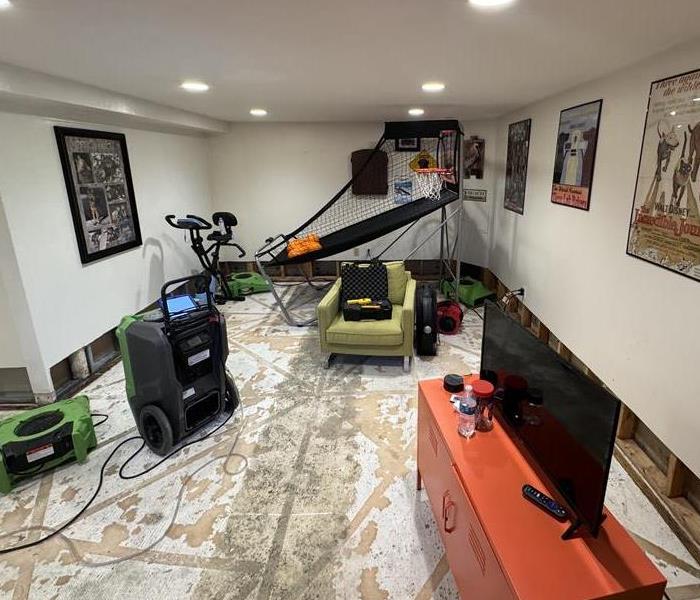 Air movers and Dehumidifiers placed for a clean and dry full reconstruction
Air movers and Dehumidifiers placed for a clean and dry full reconstruction
A homeowner's worst nightmare unfolded when a failed sump pump turned their basement into a watery mess. But in moments of distress, the swift and efficient response of SERVPRO of Media and SERVPRO of Central Delaware County shines as a beacon of hope.
Upon receiving the frantic call for help, our teams sprung into action. Recognizing the urgency of the situation, we mobilized our skilled technicians and advanced equipment without delay. Time is of the essence in water damage restoration, and we wasted none.
Upon arrival, our first task was to assess the extent of the damage. With precision and expertise, we swiftly identified the affected areas and devised a comprehensive restoration plan. Our goal was to minimize disruption and swiftly return the homeowner's sanctuary to its pre-damage condition.
With the floodwaters contained, our extraction process commenced. Our powerful pumps and extraction tools worked tirelessly to remove standing water, leaving no corner untouched. Every minute counted, and our efficient workflow ensured rapid progress.
As water was extracted, our attention turned to salvaging belongings. Our team delicately handled items affected by water damage, employing advanced techniques to restore what could be saved. With meticulous care, we worked to alleviate the homeowner's distress and preserve cherished possessions.
Simultaneously, our drying and dehumidification process kicked into high gear. Utilizing industrial-grade equipment, we swiftly restored optimal humidity levels, preventing mold growth and further damage. Our thorough approach left no room for compromise, ensuring a complete and lasting restoration.
Throughout the process, clear communication was paramount. Our team kept the homeowner informed at every stage, providing reassurance and transparency. In moments of uncertainty, our unwavering support served as a guiding light, instilling confidence and peace of mind.
As the restoration neared completion, the once-damaged basement underwent a remarkable transformation. What was once a scene of chaos and despair now stood as a testament to our swift and efficient service. The homeowner breathed a sigh of relief, grateful for our rapid response and meticulous attention to detail.
In Newtown Square and beyond, SERVPRO® is synonymous with swift restoration and unwavering support. When disaster strikes, trust the experts who make it "Like it never even happened."
How SERVPRO Saved a Home with Emergency Tree Removal and Tarp Up Service
5/14/2024 (Permalink)
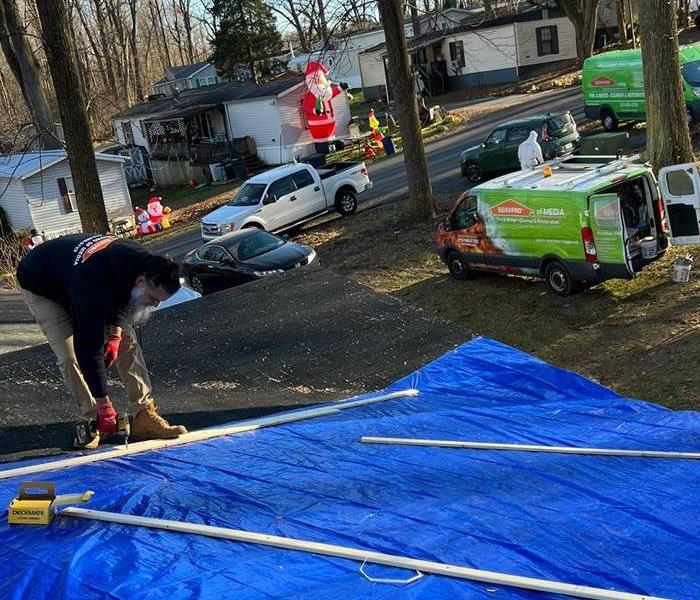 Tarping up the roof which was damaged by a fallen tree during a storm. Mitigating further storm damage
Tarping up the roof which was damaged by a fallen tree during a storm. Mitigating further storm damage
When a violent storm brought chaos in the form of a fallen tree damaging a roof of a homeowner in Newtown Square, SERVPRO of Media and SERVPRO of Central Delaware County swiftly emerged as beacons of hope, providing timely assistance that turned disaster into relief.
The distress call from the homeowner triggered an immediate response from our dedicated team. Understanding the urgency of the situation, we mobilized our skilled technicians equipped with specialized tools to assess the damage and take decisive action. With the safety of the homeowners and their property as our top priority, we wasted no time in formulating a strategic plan to mitigate further damage.
Upon arrival at the scene, our first task was to evaluate the extent of the damage caused by the fallen tree. With meticulous attention to detail, our technicians assessed potential risks and hazards, ensuring a safe and efficient removal process. With precision and expertise, we proceeded to clear the tree debris from the roof, clearing the path for restoration to begin.
As the tree removal operation unfolded, our focus shifted to preventing additional damage to the exposed area of the roof. Recognizing the importance of swift action, our tarp up services came into play. With expert precision, we secured a durable tarp over the damaged section of the roof, effectively shielding the home from the elements and providing temporary protection until permanent repairs could be made.
Throughout the entire process, clear communication and transparency remained paramount. Our team kept the homeowners informed at every step, providing reassurance and peace of mind during a time of uncertainty. From the initial assessment to the final cleanup, we worked tirelessly to ensure the homeowners' needs were met with professionalism and compassion.
In the end, what could have been a devastating situation transformed into a story of resilience and restoration, thanks to the rapid and decisive intervention of SERVPRO of Media and SERVPRO of Central Delaware County. By providing emergency tree removal and tarp up services in Newtown Square, we not only prevented further damage to the home but also delivered much-needed relief to the homeowners in their time of need.
When disaster strikes, trust the experts at SERVPRO® to provide prompt and reliable assistance that restores peace of mind and helps homeowners get back on their feet.
Rebuilding Hope: SERVPRO's Seamless Fire Damage Restoration and Reconstruction Journey in Media and Central Delaware County
5/14/2024 (Permalink)
 We assisted these homeowners in remediation and demolition and a full reconstruction of their fire-damaged property.
We assisted these homeowners in remediation and demolition and a full reconstruction of their fire-damaged property.
In moments of adversity, the strength of a community shines brightest. When a fire ravaged a home in Broomall, Pennsylvania, SERVPRO of Media and SERVPRO of Central Delaware County emerged as pillars of support, guiding homeowners through a seamless restoration and reconstruction process in partnership with their insurance, offering solace and hope in the wake of tragedy.
The aftermath of a fire is a harrowing experience for any homeowner, fraught with uncertainty and distress. But amidst the chaos, SERVPRO® stood ready to provide reassurance and expert guidance every step of the way.
Upon receiving the distress call, our dedicated technicians sprang into action, arriving promptly to assess the damage and formulate a comprehensive restoration plan. With meticulous attention to detail, we surveyed the extent of the fire damage, identifying areas requiring immediate attention and outlining the path forward.
But our commitment to restoration extended beyond mere cleanup. Recognizing the emotional toll of a fire, we prioritized open communication and transparency, ensuring homeowners felt supported and informed throughout the entire process. From coordinating with insurance adjusters to answering questions and addressing concerns, our team served as steadfast allies in the journey towards recovery.
As the restoration progressed, our focus shifted to reconstruction, transforming charred remains into a beacon of hope and renewal. Working closely with the homeowners' insurance, we navigated the complexities of the claims process, alleviating the burden and streamlining the path to restoration.
With precision and expertise, our skilled craftsmen embarked on the reconstruction phase, breathing new life into the fire-damaged home. From structural repairs to cosmetic enhancements, every detail was meticulously executed, restoring the home to its pre-fire condition and beyond.
Throughout the entire restoration and reconstruction journey, our unwavering commitment to excellence never wavered. By leveraging our extensive experience and industry-leading techniques, we delivered results that surpassed expectations, ensuring homeowners could once again find comfort and solace within their restored abode.
In the end, what began as a traumatic event transformed into a story of resilience and renewal, thanks to the collaborative efforts of SERVPRO of Media, SERVPRO of Central Delaware County, and the homeowners' insurance. Together, we navigated the challenges of fire damage restoration and reconstruction, creating a seamless and less stressful process that paved the way for healing and restoration.
When disaster strikes, trust SERVPRO to be your guiding light in the journey towards recovery. With compassion, expertise, and unwavering support, we're here to rebuild hope and restore peace of mind, one home at a time.
Rebuilding Hope: SERVPRO's Seamless Fire Damage Restoration and Reconstruction Journey in Media and Central Delaware County
5/14/2024 (Permalink)
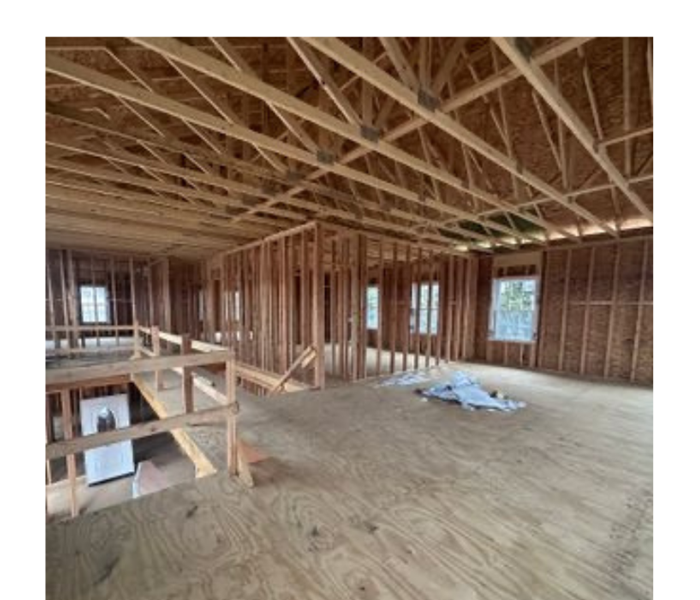 We assisted these homeowners in remediation and demolition and a full reconstruction of their fire-damaged property.
We assisted these homeowners in remediation and demolition and a full reconstruction of their fire-damaged property.
In moments of adversity, the strength of a community shines brightest. When a fire ravaged a home in Broomall, Pennsylvania, SERVPRO of Media and SERVPRO of Central Delaware County emerged as pillars of support, guiding homeowners through a seamless restoration and reconstruction process in partnership with their insurance, offering solace and hope in the wake of tragedy.
The aftermath of a fire is a harrowing experience for any homeowner, fraught with uncertainty and distress. But amidst the chaos, SERVPRO® stood ready to provide reassurance and expert guidance every step of the way.
Upon receiving the distress call, our dedicated technicians sprang into action, arriving promptly to assess the damage and formulate a comprehensive restoration plan. With meticulous attention to detail, we surveyed the extent of the fire damage, identifying areas requiring immediate attention and outlining the path forward.
But our commitment to restoration extended beyond mere cleanup. Recognizing the emotional toll of a fire, we prioritized open communication and transparency, ensuring homeowners felt supported and informed throughout the entire process. From coordinating with insurance adjusters to answering questions and addressing concerns, our team served as steadfast allies in the journey towards recovery.
As the restoration progressed, our focus shifted to reconstruction, transforming charred remains into a beacon of hope and renewal. Working closely with the homeowners' insurance, we navigated the complexities of the claims process, alleviating the burden and streamlining the path to restoration.
With precision and expertise, our skilled craftsmen embarked on the reconstruction phase, breathing new life into the fire-damaged home. From structural repairs to cosmetic enhancements, every detail was meticulously executed, restoring the home to its pre-fire condition and beyond.
Throughout the entire restoration and reconstruction journey, our unwavering commitment to excellence never wavered. By leveraging our extensive experience and industry-leading techniques, we delivered results that surpassed expectations, ensuring homeowners could once again find comfort and solace within their restored abode.
In the end, what began as a traumatic event transformed into a story of resilience and renewal, thanks to the collaborative efforts of SERVPRO of Media, SERVPRO of Central Delaware County, and the homeowners' insurance. Together, we navigated the challenges of fire damage restoration and reconstruction, creating a seamless and less stressful process that paved the way for healing and restoration.
When disaster strikes, trust SERVPRO to be your guiding light in the journey towards recovery. With compassion, expertise, and unwavering support, we're here to rebuild hope and restore peace of mind, one home at a time.
Biohazard Cleanup: How SERVPRO of Media Handles the Toughest Situations
4/9/2024 (Permalink)
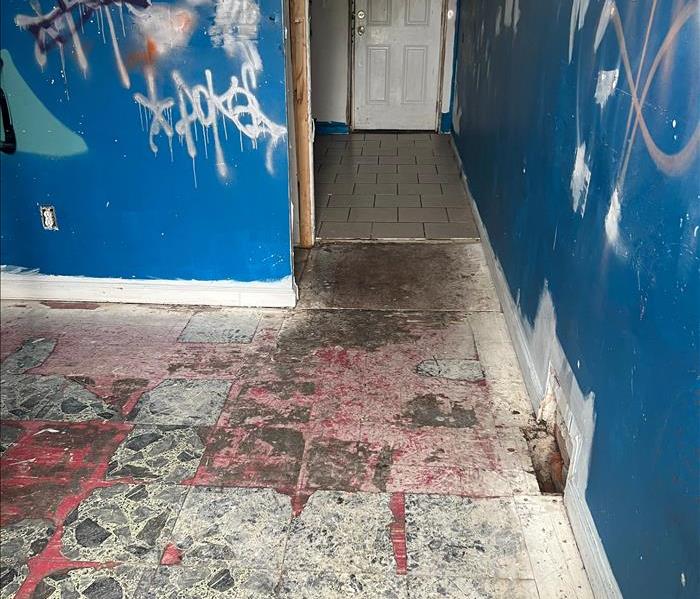 This residence was damaged by renters and painted throughout with graffiti. The extensive damage was remediated and repaired by our expert team!
This residence was damaged by renters and painted throughout with graffiti. The extensive damage was remediated and repaired by our expert team!
Dealing with biohazardous situations can be incredibly challenging and emotionally taxing. Whether it's the aftermath of a crime scene, an accident, or a hazardous waste spill, these situations require specialized expertise and a compassionate approach. At SERVPRO® of Media, we understand the complexities involved in biohazard cleanup and are dedicated to providing efficient, discreet, and compassionate services to the residents and businesses of Media and nearby areas.
Adherence to Safety Protocols: When it comes to biohazard cleanup, safety is paramount. SERVPRO of Media adheres strictly to industry-leading safety protocols and guidelines to ensure the protection of our team members, our clients, and the environment. Our technicians are trained in the proper handling and disposal of biohazardous materials, utilizing personal protective equipment (PPE) and advanced cleaning techniques to mitigate risks and prevent cross-contamination.
Discretion: We recognize that biohazard cleanup often involves sensitive and private situations. That's why SERVPRO of Media prioritizes discretion and confidentiality in all our operations. Our team arrives in unmarked vehicles and works swiftly and discreetly to restore the affected area to its pre-biohazard condition, minimizing disruptions and preserving the privacy of our clients.
Compassionate Approach: At SERVPRO of Media, we understand the emotional toll that biohazard situations can take on individuals and families. That's why we approach every job with empathy, compassion, and respect. Our technicians are trained to handle these challenging situations with sensitivity and professionalism, providing support and reassurance to those affected.
Our Process: When you choose SERVPRO of Media for biohazard cleanup, you can expect a thorough and meticulous process tailored to your specific needs:
Assessment: Our team conducts a comprehensive assessment of the biohazardous situation, identifying all affected areas and materials.
Cleanup: Using specialized equipment and cleaning agents, we safely and effectively remove biohazardous materials, including blood, bodily fluids, and other contaminants.
Disinfection: We disinfect and sanitize the affected area to eliminate bacteria, viruses, and other pathogens, ensuring a safe and hygienic environment.
Deodorization: We employ advanced deodorization techniques to remove any lingering odors, restoring the space to a clean and fresh condition.
Restoration: Depending on the extent of the damage, we may perform repairs or restoration to return the property to its pre-biohazard condition, ensuring complete peace of mind for our clients.
When faced with biohazardous situations, you need a team you can trust to handle the cleanup with professionalism, discretion, and compassion. SERVPRO of Media is your trusted partner for biohazard cleanup in Media and nearby areas. With our adherence to safety protocols, discretion, and compassionate approach, we are here to help you navigate these challenging times and restore your property to a safe and healthy condition. Contact us today for expert biohazard cleanup services you can rely on.
Steps to Take After Storm Damage in Springfield P.A.
2/27/2024 (Permalink)
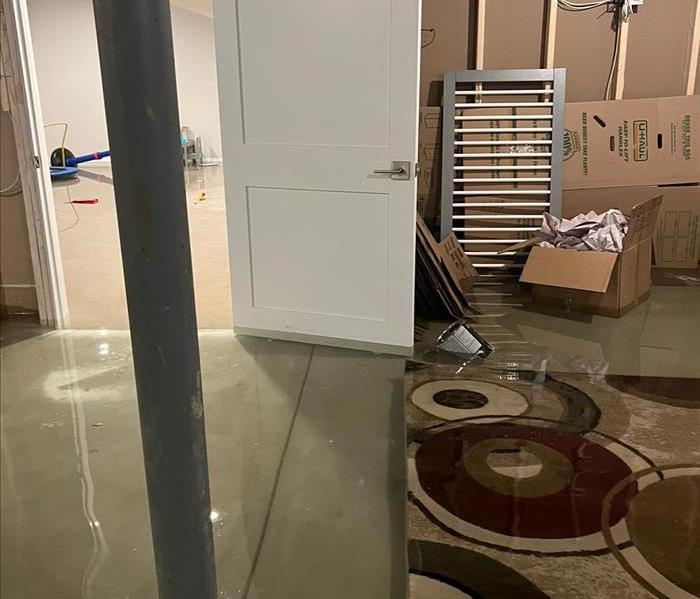 This flooding in a customers basement was caused by a recent storm
This flooding in a customers basement was caused by a recent storm
Natural disasters like storms can wreak havoc on homes and businesses, leaving behind a trail of destruction. When faced with the aftermath of a storm, it's crucial to act swiftly and efficiently to minimize further damage and begin the restoration process. In such situations, professional assistance becomes invaluable. One trusted name in storm damage restoration is SERVPRO of Media, known for its expertise and prompt response. In this blog post, we'll discuss the essential steps to take after experiencing storm damage and how and when to contact SERVPRO of Media for assistance.
Ensure Safety: Before anything else, prioritize safety. Assess the area for any immediate dangers such as fallen power lines, structural damage, or gas leaks. If the damage is severe or if you're unsure of safety, evacuate the premises and wait for professionals to give the all-clear.
Document the Damage: Take photographs or videos of the damage for insurance purposes. Documenting the extent of the damage will help with your insurance claim and serve as evidence for the restoration process.
Mitigate Further Damage: If it's safe to do so, take steps to prevent further damage. This might include placing tarps over roof leaks, boarding up broken windows, or removing standing water to prevent mold growth.
Contact Your Insurance Provider: Notify your insurance company about the damage as soon as possible. Provide them with the necessary documentation and details of the incident to initiate the claims process.
Assess the Need for Professional Assistance: While you might be able to handle minor cleanup tasks, significant storm damage often requires professional help. SERVPRO of Media specializes in storm and water damage restoration, offering expertise, equipment, and manpower to expedite the restoration process.
Contact SERVPRO of Media: Once you've ensured safety, documented the damage, and contacted your insurance provider, it's time to reach out to SERVPRO of Media. Their team of trained professionals will conduct a thorough assessment of the damage and develop a tailored restoration plan.
Evaluation and Restoration Plan: SERVPRO of Media will assess the extent of the damage, including water damage, structural issues, and potential mold growth. Based on their evaluation, they'll outline a comprehensive restoration plan, detailing the necessary steps and timeline for restoration.
Restoration Process: With the restoration plan in place, SERVPRO of Media will begin the restoration process promptly. This may include water extraction, drying and dehumidification, structural repairs, mold remediation, and thorough cleaning of affected areas.
Communication and Updates: Throughout the restoration process, SERVPRO of Media will maintain clear communication with you, providing regular updates on progress and any adjustments to the restoration plan as needed.
Completion and Follow-Up: Once the restoration is complete, SERVPRO of Media will conduct a final inspection to ensure that all damage has been addressed and that the property is safe and habitable. They'll also provide guidance on preventive measures to minimize future storm damage risks.
Why SERVPRO of Media Stands Out Among the Competition
2/27/2024 (Permalink)
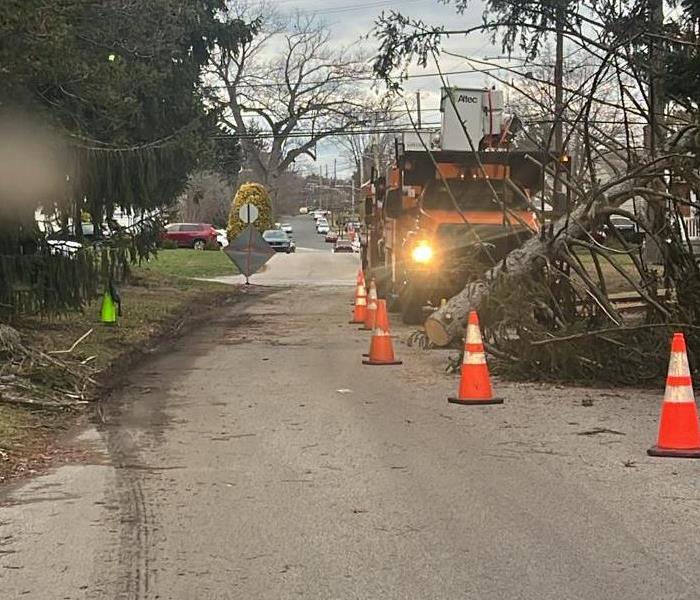 This is a picture our crew took driving through the community, after a bad storm our crew hit the road to help home and business owners.
This is a picture our crew took driving through the community, after a bad storm our crew hit the road to help home and business owners.
When disaster strikes, whether it's a devastating storm, a fire, or a flood, the aftermath can be overwhelming. Amidst the chaos of dealing with property damage, finding a reliable restoration company becomes paramount. In Springfield, Pennsylvania, there are several options, but none quite match the caliber of SERVPRO® of Media. Here's why choosing SERVPRO of Media is the smartest decision you can make in the face of adversity:
Local Presence, Global Reputation: SERVPRO of Media is part of a nationally recognized franchise with a local presence. This unique combination ensures that customers receive personalized attention backed by the resources and expertise of a renowned restoration brand. Being local means they understand the specific needs and challenges of the community, allowing for faster response times and tailored solutions.
Rapid Response: Time is of the essence in restoration efforts. SERVPRO of Media understands the urgency of the situation and is available 24/7 to respond to emergencies promptly. Their swift response mitigates further damage and reduces downtime, getting your life back to normal as quickly as possible.
Trained and Certified Technicians: Entrusting your property to just anyone is risky. With SERVPRO of Media, you can rest assured that your property is in capable hands. Their technicians undergo rigorous training and certification processes to ensure they are equipped with the latest techniques and tools for efficient restoration. From water extraction to mold remediation, they have the expertise to handle any situation with precision and care.
Comprehensive Services: Whether it's water damage, fire damage, mold remediation, or storm damage, SERVPRO of Media offers a comprehensive range of services to address all your restoration needs. They employ advanced technology and proven methods to restore your property to its preloss condition, no matter the extent of the damage.
Insurance Assistance: Dealing with insurance companies can be daunting, especially in times of crisis. SERVPRO of Media takes the stress out of the process by assisting you with insurance claims. Their team works closely with insurance providers to ensure a smooth and hassle-free experience, allowing you to focus on rebuilding your life.
Community Involvement: SERVPRO of Media is more than just a restoration company; they are active members of the Springfield, P.A. community. They understand the importance of giving back and are committed to supporting local initiatives and charities. By choosing SERVPRO of Media, you're not just getting exceptional service – you're also contributing to the betterment of your community.
Customer Satisfaction Guarantee: Above all, SERVPRO of Media prioritizes customer satisfaction. They go above and beyond to exceed expectations and ensure that every customer is completely satisfied with the results. From the initial assessment to the final walkthrough, they are dedicated to delivering quality service with integrity and professionalism.
When it comes to restoring your property, whether it is a commercial or residential property in after a disaster, choosing SERVPRO of Media is the clear choice. With their local expertise, global reputation, rapid response, trained technicians, comprehensive services, insurance assistance, community involvement, and commitment to customer satisfaction, you can trust SERVPRO of Media to restore your peace of mind along with your property. Don't settle for less when you can have the best – choose SERVPRO of Media for all your restoration needs.
The Unseen Peril: Understanding Water Damage and Its Impacts
2/21/2024 (Permalink)
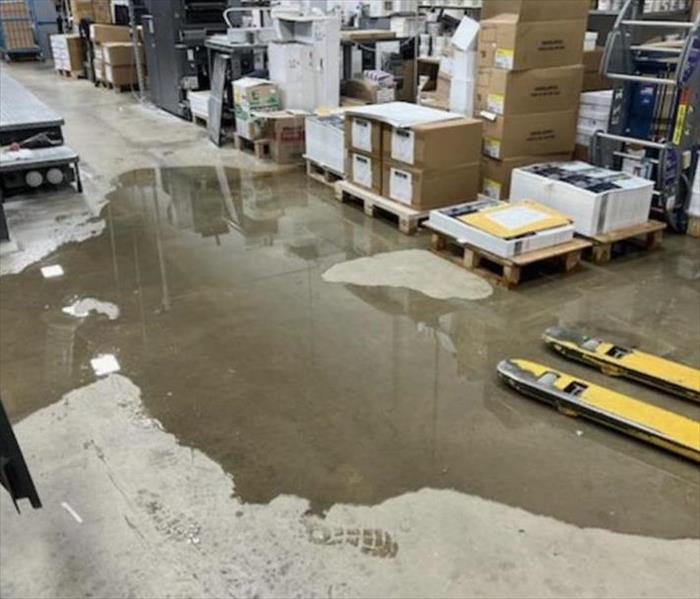 This flooded warehouse was caused by a recent storm.
This flooded warehouse was caused by a recent storm.
Water damage can be a silent destroyer, wreaking havoc on homes and businesses alike. Whether it's a burst pipe, a leaking roof, or a flooded basement, the consequences can be devastating if not addressed promptly and effectively. At SERVPRO of Media, we understand the urgency and importance of mitigating water damage, which is why we're here to shed light on this often-underestimated threat.
The Stealthy Intruder
Water damage doesn't always make its presence known immediately. In fact, it can lurk beneath the surface for days, weeks, or even months before its effects become apparent. What starts as a small leak or minor seepage can escalate into a full-blown disaster, compromising structural integrity, damaging possessions, and fostering the growth of mold and mildew.
The Costly Consequences
The financial toll of water damage can be staggering. Repairing structural damage, replacing damaged belongings, and addressing mold infestations can add up quickly, leaving homeowners and business owners grappling with hefty bills. Moreover, water damage can also lead to secondary issues like electrical hazards and compromised indoor air quality, further exacerbating the problem.
The Importance of Swift Action
When it comes to water damage, time is of the essence. Acting swiftly to address the issue can help minimize damage, reduce repair costs, and prevent long-term consequences. That's where SERVPRO of Media comes in. Our team of highly trained professionals is equipped with the knowledge, experience, and cutting-edge tools to swiftly assess the situation, develop a customized mitigation plan, and restore your property to its pre-damaged condition.
Our Comprehensive Approach
At SERVPRO of Media, we take a comprehensive approach to water damage restoration. From water extraction and drying to mold remediation and structural repairs, we handle every aspect of the restoration process with precision and care. Our goal is not only to restore your property but also to provide peace of mind in the midst of a challenging situation.
The SERVPRO Difference
What sets SERVPRO of Media apart is our unwavering commitment to excellence and customer satisfaction. With years of experience in the industry and a proven track record of success, we have earned the trust and respect of countless homeowners and business owners in the Media area. When you choose SERVPRO, you can rest assured that you're in good hands.
Don't Wait, Act Now
Water damage may be invisible, but its effects are anything but. Don't wait until it's too late to address the issue. If you suspect water damage in your home or business, contact SERVPRO of Media immediately. Our team is available 24/7 to respond to emergencies and provide the prompt, professional service you need to mitigate the damage and restore your property.
Water damage is a formidable foe, but with the right knowledge, preparation, and professional assistance, it can be overcome. At SERVPRO of Media, we're dedicated to helping our community navigate the challenges of water damage and emerge stronger on the other side. Trust us to be your partner in restoration, every step of the way.






 24/7 Emergency Service
24/7 Emergency Service
